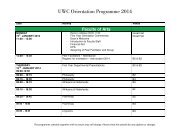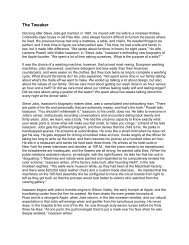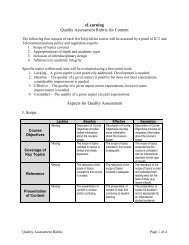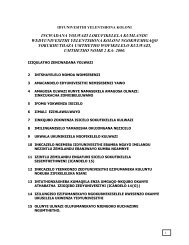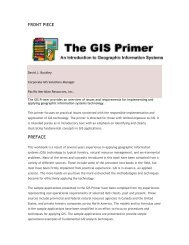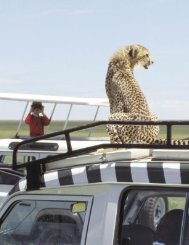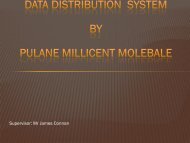Ecosystem Guidelines for Environmental Assessment
Ecosystem Guidelines for Environmental Assessment
Ecosystem Guidelines for Environmental Assessment
Create successful ePaper yourself
Turn your PDF publications into a flip-book with our unique Google optimized e-Paper software.
COASTAL<br />
Strandveld is also increasingly under pressure from urbanisation, especially southwards from<br />
Lambert’s Bay.<br />
There is a relatively low diversity of habitat endemics and rare species in West Coast Strandveld.<br />
Rare species tend to be concentrated in specific habitats (often in rocky areas) hence their vulnerability<br />
to mining and quarrying. Grazing is seldom of sufficient intensity to be a major threat. Wetland areas<br />
are very sensitive to lowered water tables, hence their vulnerability to over-utilisation of aquifers (see<br />
Guideline 7, Freshwater <strong>Ecosystem</strong>s p.68).<br />
In Strandveld, alien plant invasion is largely unimportant, except <strong>for</strong> old man saltbush Atriplex spp.<br />
However, in the southern and eastern coastal areas, disturbed Dune Thicket is very vulnerable to<br />
invasion by woody alien plant species such as rooikrans Acacia cyclops.<br />
Dune Thicket in the southern and south-eastern coastal regions usually supports high densities of<br />
small animals and birds, but few rare or local plant species.<br />
This vegetation type is very vulnerable to altered natural fire regimes, especially fire frequency. In<br />
the absence of fire, fynbos elements in dune thicket can become senescent and prone to colonisation<br />
by thicket vegetation.<br />
Strandveld and Dune Thicket close to settlements can be vulnerable to hunting and very few game<br />
species such as porcupine or antelope are left in these areas.<br />
Resort and urban development poses the main threat to Strandveld, along with associated impacts<br />
such as hunting, fires, dumping and trampling.<br />
Uncontrolled driving by off-road<br />
vehicles is a major problem in certain areas.<br />
Dune Thicket is one of the vegetation types<br />
most heavily impacted by rapidly expanding<br />
coastal developments, and its conservation<br />
status will have to be revised regularly.<br />
Coastal dune systems are vulnerable to<br />
“blowouts” when the vegetation cover is<br />
disturbed.<br />
Migration corridors of certain bird<br />
species can be fragmented when Dune<br />
Thicket is lost or a connective matrix of non-<br />
Thicket vegetation is trans<strong>for</strong>med.<br />
Once disturbed, Dune Thicket is prone to<br />
Ecological corridors should be at least 20 m wide in Dune Thicket,<br />
invasion by woody alien plants such as<br />
and development must be well set back from estuaries and wetlands.<br />
Acacia cyclops.<br />
ANDREW BROWN<br />
What are the “bottom lines” and non-negotiables<br />
In the West Coast and Namaqualand regions, it is important to keep coastal/ inland (west-east)<br />
gradients intact.<br />
In the south-western area (Cape Town-Lambert’s Bay), at least 80% of the remaining Strandveld<br />
should be retained. All special habitats should be conserved, e.g. unique mineral-rich dunes, Odysseadominated<br />
grasslands and rocky outcrops.<br />
Due to its aridity Strandveld is slow to recover after physical disturbance and fires. Physical<br />
disturbance and fires there<strong>for</strong>e should be limited to the minimum in Strandveld.<br />
As a general rule, connectivity must be maintained and fragmentation of habitat actively avoided.<br />
This is particularly relevant in Dune Thicket and Dune Fynbos. Remnants can be very small and remain<br />
34 : STRANDVELD, DUNE THICKET & DUNE FYNBOS



